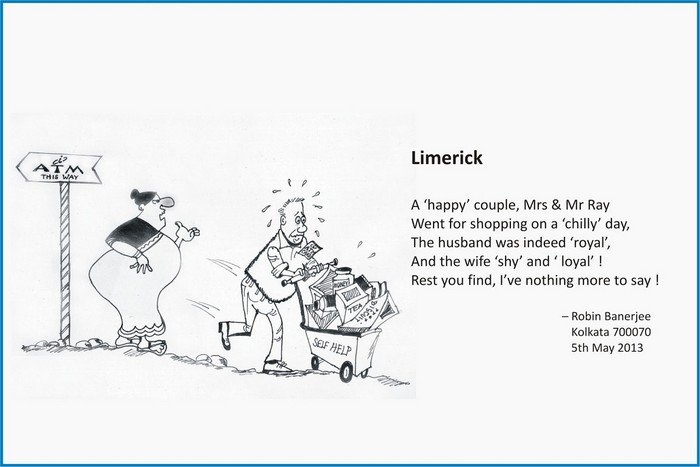In the realm of poetry, the limerick stands out as a unique and playful form, known for its witty and humorous nature. Among the variations of this poetic style, the 5 line limerick holds a special place, offering poets a concise yet vibrant canvas to express their creativity. In this article, we will delve deep into the world of 5 line limericks, exploring their history, structure, and examples that showcase their charm and versatility.
History of the Limerick
To truly appreciate the 5 line limerick, it’s essential to understand its origins and evolution. The limerick as a form of verse is believed to have originated in England in the early 18th century. Its name is often associated with the city of Limerick in Ireland, although its exact connection to the city’s name remains unclear.
Early limericks were often lewd or nonsensical, shared orally among friends or in social gatherings. They typically followed a strict rhyme scheme and meter, which contributed to their rhythmic and catchy nature. Over time, limericks gained popularity and began to appear in print, solidifying their place in literary circles.
The Structure of a 5 Line Limerick
A 5 line limerick follows a specific structure that sets it apart from other forms of poetry. Understanding this structure is key to crafting a successful limerick that captures the essence of wit and humor. The typical structure of a 5 line limerick is as follows:
1. The first line sets the scene or introduces the main character.
2. The second and fifth lines rhyme with each other and have a specific meter.
3. The third and fourth lines rhyme with each other but have a different meter than the second and fifth lines.
4. The meter of a limerick is often described as anapestic trimeter, with three metrical feet in each line and a specific pattern of stressed and unstressed syllables.
Here is an example of the meter in a 5 line limerick:
da DA da da DA da da DA (1)
da DA da da DA da da DA (2)
da DA da da DA (3)
da DA da da DA (4)
da DA da da DA da da DA (5)
In this pattern, “da” represents an unstressed syllable, and “DA” represents a stressed syllable. Maintaining this meter is crucial for the limerick’s rhythm and flow.
Examples of 5 Line Limericks
To further illustrate the charm and versatility of 5 line limericks, let’s explore some examples across different themes and styles:
1. Humorous Limerick:
There once was a cat named Pat,
Who always wore a big hat.
He’d dance and he’d prance,
With each feline glance,
And fancy himself quite the diplomat.
2. Nature-Themed Limerick:
In a meadow, a daisy did bloom,
Its petals kissed softly by the noon.
With a fragrance so sweet,
It made hearts skip a beat,
Nature’s beauty in full, not a gloom.
3. Historical Limerick:
In olden times of knights and kings,
Where troubadours strummed with strings,
Fair maidens did sigh,
Beneath starlit sky,
As tales of love took flight on wings.
4. Science-Fiction Limerick:
On a planet beyond the stars,
Aliens drove fancy space cars.
With antennae high,
They zoomed through the sky,
Exploring the cosmos, no bars.
5. Philosophical Limerick:
In the depths of a pondering mind,
Existence’s questions we find.
With wisdom sought,
And truths unsought,
Life’s mysteries intertwined.
These examples showcase the range of topics and tones that can be explored through 5 line limericks, from light-hearted humor to introspective musings.
Tips for Writing a 5 Line Limerick
Crafting a successful 5 line limerick requires a blend of creativity, wit, and attention to structure. Here are some tips to help you write compelling limericks:
1. Choose a Topic: Start by selecting a theme or subject for your limerick. Whether it’s a funny anecdote, a nature-inspired scene, or a philosophical thought, having a clear focus will guide your writing.
2. Establish the Rhyme Scheme: Remember the rhyme scheme of AABBA for a 5 line limerick. The first, second, and fifth lines should rhyme with each other, while the third and fourth lines should rhyme with each other but have a different meter.
3. Maintain the Meter: Pay attention to the anapestic trimeter meter of a limerick. Ensure each line has three metrical feet with the appropriate stress pattern (da DA da da DA da).
4. Inject Humor or Wit: Limericks are known for their humor and wit. Use wordplay, puns, or unexpected twists to create an engaging and entertaining poem.
5. Revise and Refine: Once you’ve drafted your limerick, revise it for clarity, rhythm, and impact. Remove any unnecessary words and fine-tune the rhyme and meter for maximum effect.
Conclusion
The 5 line limerick is a delightful form of poetry that offers poets a compact yet expressive canvas to showcase their creativity. With its structured rhyme scheme, distinct meter, and playful nature, limericks continue to captivate readers and listeners alike. Whether you’re crafting a humorous tale, exploring nature’s beauty, or delving into deeper themes, the 5 line limerick provides a versatile platform for poetic expression. So, pick up your pen and let your imagination soar as you dive into the art of the 5 line limerick.

